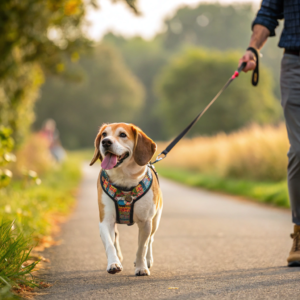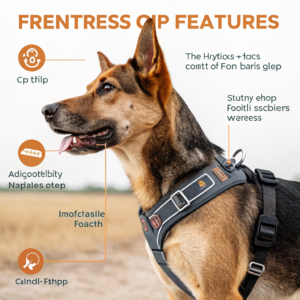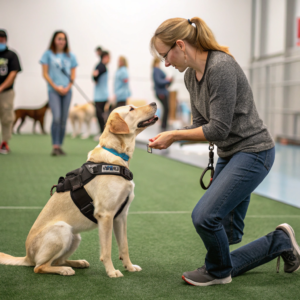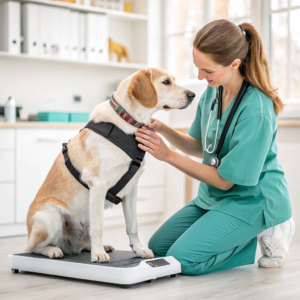Dog Harness: Ensuring Comfort, Safety, and Control?
I struggled daily with my energetic Lab who pulled so hard on walks that my shoulders ached. His choking and gagging worried me, and I dreaded our walks until I discovered how the right harness could transform our experience.
**A good dog harness distributes pressure across the chest instead of the throat, provides better control than collars, prevents escape, and A good dog harness1 distributes pressure across the chest instead of the throat, provides better control than collars, prevents escape, and reduces pulling

After trying five different harnesses, I finally found one that worked for both of us. Our walks transformed from stressful ordeals into enjoyable adventures. If you’re struggling with similar issues, understanding harness options and finding the right fit could be game-changing for you and your furry friend.
What Is the Best Dog Harness for Control?
Walking my strong, reactive dog was a nightmare. He lunged at squirrels, pulled towards other dogs, and I felt completely powerless to maintain control. I worried constantly about his safety and my ability to handle him in unexpected situations.
**The best harness for control is a front-clip or dual-clip harness with reinforced attachment points andThe best harness for control is a front-clip or dual-clip harness1 with reinforced attachment points and adjustable straps

The first time I walked my dog Max with a proper control harness, the difference was remarkable. Instead of being dragged around, I could finally maintain a comfortable pace and redirect his attention when needed. Finding the right control solution changed everything about our relationship.
When it comes to control, not all harnesses are created equal. Different designs offer varying levels of control and work better for specific situations and dog behaviors. I’ve learned through experience that matching the harness type to your specific control needs is essential for success.
Front-clip harnesses provide excellent control for most dogs by using simple physics to your advantage. When your dog pulls forward, the front attachment point creates a turning motion rather than allowing them to move straight ahead. This mechanical advantage doesn’t rely on pain or restriction but instead makes pulling less efficient and rewarding for your dog.
For more challenging control issues, these specialized options offer enhanced features:
| Harness Type | Control Features | Best For | Considerations |
|---|---|---|---|
| Front-clip harness | Chest attachment point redirects momentum | General pulling, everyday use | May need replacement as straps stretch |
| Dual-clip harness | Front and back attachment options | Training progression, versatility | Slightly bulkier design |
| Head halter | Controls head direction for precise steering | Reactive dogs, extreme pullers | Requires gradual introduction |
| Tightening harness | Applies pressure when pulling occurs | Strong, stubborn pullers | Use carefully to avoid negative associations |
| Tactical/working dog harness | Multiple handle points, reinforced structure | Service dogs, training scenarios | Heavier, may be too much for casual use |
I’ve found that material and construction significantly impact control. Look for harnesses with reinforced stitching at stress points, sturdy hardware that won’t bend or break under pressure, and attachment points that distribute force evenly rather than concentrating it in one area.
For Max, our breakthrough came with a dual-clip harness that allowed me to use both attachment points with a double-ended leash. This setup gave me precise control during training sessions while allowing more freedom when he demonstrated good behavior. As his training improved, I gradually transitioned to using just the back clip for most walks.
The most effective control comes from combining the right harness with consistent training. I establish clear expectations through positive reinforcement, rewarding calm walking behavior and teaching directional cues. The harness provides immediate management while these longer-term training efforts take hold. Remember that even the best control harness is a tool to support training, not replace it.
Why Do Dog Trainers Not Recommend Harnesses?
When I mentioned getting a harness to my dog trainer, I was surprised by her hesitation. She explained concerns about harnesses encouraging pulling, restricting movement, and interfering with proper training techniques. I felt confused about the conflicting information.
Some dog trainers don’t recommend certain harnesses because poorly designed ones can encourage pulling (especially back-clip only designs), restrict natural movement, or cause rubbing and discomfort. However, many professional trainers do advocate for properly fitted, well-designed harnesses as training tools, particularly front-clip or dual-attachment options.

I decided to research deeper and consult multiple trainers. I discovered that trainer opinions vary widely based on their training philosophy, experience, and the specific harnesses they’ve worked with. Understanding the nuances of these perspectives helped me make a more informed decision.
The resistance to harnesses among some trainers stems from legitimate concerns about specific designs and improper use. Many trainers have seen the negative effects of ill-fitting or poorly designed harnesses that create new problems instead of solving existing ones. However, this doesn’t mean all trainers oppose all harnesses – the reality is much more nuanced.
Training philosophies significantly influence harness recommendations:
| Training Approach | View on Harnesses | Reasoning | Preferred Solutions |
|---|---|---|---|
| Traditional/correction-based | Often skeptical of harnesses | May believe they reduce handler control | Prefer training collars |
| Balanced training | Selective use of harnesses | Evaluate based on individual dog needs | May use both harnesses and collars situationally |
| Positive reinforcement | Generally support well-designed harnesses | Focus on comfort and positive associations | Favor front-clip and properly fitted options |
| Behavior modification specialists | Often recommend specific harness types | Match tool to specific behavior issues | Frequently use dual-clip designs |
The specific concerns many trainers have about harnesses include:
- Back-clip-only harnesses can trigger the opposition reflex (pushing against pressure), potentially reinforcing pulling behavior
- Restrictive harnesses may alter natural gait and movement, especially those that cross over shoulder joints
- Some harnesses can cause chafing or discomfort, creating negative associations with walking
- Over-reliance on harnesses without proper training can mask problems rather than solve them
- Poorly fitted harnesses may allow escape or cause injury
After speaking with several trainers, I found that many modern, After speaking with several trainers, I found that many modern, science-based trainers actually recommend specific harness types1 when matched appropriately to the dog’s needs
Trainers who focus on positive methods often prefer harnesses over collars because they distribute pressure more evenly and avoid potential trachea damage. The key is selecting a harness designed for your specific training goals and using it properly as part of a comprehensive training approach.
I’ve learned to be skeptical of absolute statements against all harnesses. The effectiveness depends greatly on the specific design, proper fit, and how it’s incorporated into your overall training strategy. When used correctly, a well-designed harness can be a valuable tool that supports rather than hinders training progress.
What Harness Do Vets Recommend?
After my dog developed a persistent cough, my vet suggested switching from a collar to a harness. I was surprised to learn about the potential health risks of collars and wanted to understand what harness features veterinarians actually recommend for safety and well-being.
Veterinarians typically recommend Y-shaped or H-shaped harnesses that distribute pressure across the chest rather than the neck, throat, or shoulders. They advise against restrictive designs that impede natural movement. For brachycephalic breeds (like Pugs or Bulldogs), vets strongly prefer harnesses over collars to protect compromised respiratory systems.

My vet explained that my dog’s coughing was potentially linked to tracheal irritation from his collar. After switching to a vet-recommended harness design, the coughing stopped completely within weeks. This experience showed me how important proper equipment choices are for my dog’s health.
Veterinarians’ harness recommendations are primarily driven by health and anatomical considerations rather than just training outcomes. They focus on designs that minimize physical stress and potential injury while supporting natural movement patterns. This medical perspective provides valuable insights that complement training-focused advice.
Veterinary concerns about collars include:
- Tracheal damage from pressure on the throat
- Increased intraocular pressure (dangerous for dogs with eye conditions)
- Thyroid gland trauma from repeated pressure
- Nerve damage in the neck region
- Exacerbation of respiratory issues, especially in brachycephalic breeds
When recommending harnesses, veterinarians typically focus on these health-promoting features:
| Harness Feature | Health Benefit | Particularly Important For |
|---|---|---|
| Y-shaped chest design | Distributes pressure evenly without restricting movement | Active dogs, dogs with shoulder issues |
| Padded straps | Prevents chafing and skin irritation | Short-coated breeds, sensitive skin |
| Adjustable at multiple points | Ensures proper fit to prevent rubbing | All dogs, especially those with unusual body proportions |
| No compression across throat | Protects trachea and thyroid | Brachycephalic breeds, dogs with respiratory issues |
| Allows full shoulder movement | Maintains natural gait and prevents strain | Working dogs, athletic dogs, growing puppies |
My veterinarian explained that different breeds and health conditions may warrant specific harness considerations. For example:
- Brachycephalic breeds (Pugs, Bulldogs, Boston Terriers) benefit most from harnesses that keep all pressure away from their already-compromised airways
- Dogs with orthopedic issues need harnesses that don’t restrict normal joint movement or gait
- Dogs recovering from surgery may need specialized harnesses that avoid pressure on healing areas
- Elderly dogs often do better with padded harnesses that are easy to put on and take off
For my dog with the beginning signs of tracheal irritation, my vet specifically recommended a Y-shaped harness that distributed pressure across his sternum rather than his throat. She advised against harnesses that cross over the shoulder joints or restrict natural movement.
One surprising insight was my vet’s recommendation to have both a harness and a well-fitted collar – the harness for walking and the collar primarily for ID tags. This balanced approach provides identification security while avoiding the health risks of leash pressure on the neck.
Conclusion
Choosing the right dog harness means balancing control needs, trainer recommendations, and veterinary health considerations. The best option provides comfort and safety while supporting your training goals. With proper measurement, fitting, and use, the right harness transforms walks into enjoyable experiences for both you and your dog.
-
This resource will help you choose the right harness for your dog, ensuring comfort and safety.
actually recommend specific harness types when matched appropriately to the dog’s needs. My current trainer helped me select a Y-style front-clip harness that provided control without restricting Max’s natural movement. ↩ ↩ ↩

